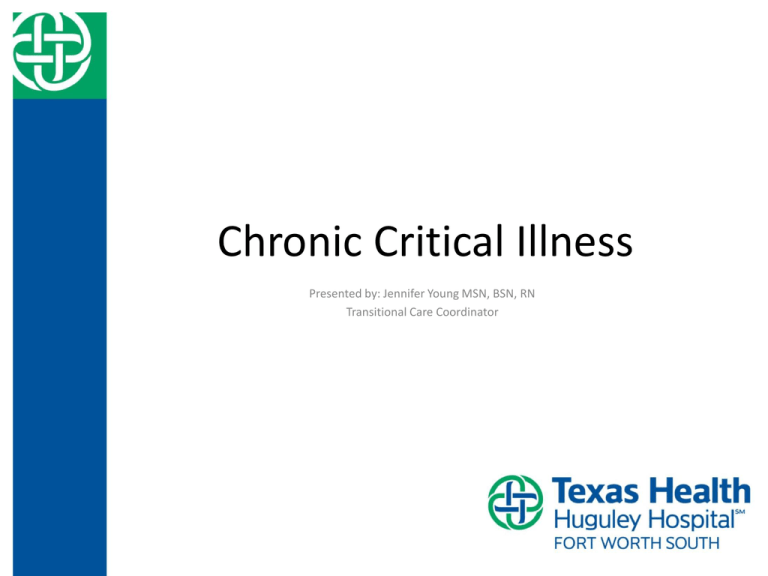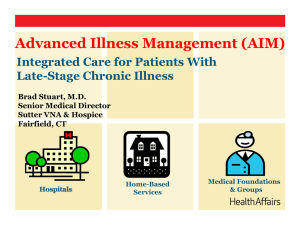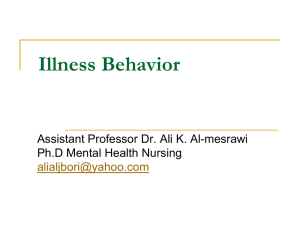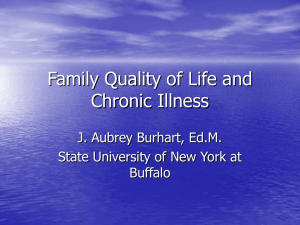Chronic Critical Illness Presentation
advertisement

Chronic Critical Illness Presented by: Jennifer Young MSN, BSN, RN Transitional Care Coordinator OBJECTIVES 1. The participant will be able to define Chronic Critical Illness. 2. The participant will understand the historical significance of Chronic Critical Illness. 3. The participant will understand the features and presentation of Chronic Critical Illness. 4. The participant will be able to identify individuals that may have or are inclined to develop Chronic Critical Illness. 5. The participant will be able to discuss the doctrines of care for the patient with Chronic Critical Illness. 6. The participant will be able to discuss and utilize the post-acute continuum of care for a patient with Chronic Critical Illness. Definition of Chronic Critical Illness • Chronic Critical Illness (CCI) is a distinct and intricate syndrome of physiologic dysfunctions, organ hindrances, neuroendocrine and immunologic changes. • Patients with CCI are found to be in the chronic state while continuing on acute life sustaining machines. • Unknown as to the specific trigger that starts CCI. • The law of unintended consequences. • Prolonged inflammation • Time frame 7-14 days? – Advanced life supporting abilities. History • In 1985 the term CCI was coined by Girard and Raffin who wrote the words in regards to CCI “to live or let die”. • Systemic Inflammatory Response (SIRS) • Multi-organ Dysfunction Syndrome (MODS) – Together SIRS and MODS help describe CCI. Demographics • Estimates indicate that there are more than 100,000 patients with CCI in the US at any given point. (this number will be growing due to the baby boomer population) • Hospital re-admission rates one year after hospital discharge exceeds 40%. • Fewer than 12% of CCI patients survive 1 year out. • Cost exceeding $20 billion each year for the US health care system Nelson, J.E., Cox, C.E., Hope, A.A., Carson, S.S. Chronic Critical Illness. American Journal of Critical Care Med. Aug. 15, 2010: 182(4): 446-454 Features of CCI • • • • • • • ICU patients Typically 65 and older Underlying chronic illness or co-morbidity Unstable Prolonged need for medical and nursing care Uncertain course or recovery. On set of CCI occurs 7-14 days after the initial onset of acute illness, insult or injury. CCI Presentation • Fluid imbalance – Overload, Anasarca, Edema • • • • • • • • • Nutritional Deficits Critical myopathy Skin impairment Anemia Muscle loss Immune system depression Neuro-endocrine dysfunction Sleep impairment/insomnia Cognitive impairment – Anxiety, Depression, Confusion, ICU psychosis. CCI Presentation Profound burden of suffering Patients • Prolonged Mechanical Ventilators – Defined by a patient being on the Ventilator for 6 hours or more per day for 21 days. • Chronic conditions with exacerbations • Organ dysfunction – Renal – Heart – Brain • Infectious disease • Severe wounds • Septic patients Pathophysiology HPA Axis Hypothalamus Activated by stress, acute insult, Other injury, or illness. This is a normal response. Anti-inflammatory Pituitary Gland Adrenal Gland Pathophysiology Adrenaline Adrenal Gland Cortisol Pathophysiology Cortisol affects the Renin-AngiotensonAldosterone system. Cortisol Water Retention Vascular Contractility Skin fragility and increased risk for pressure ulcers Pathophysiology Pituitary Corticotrophin Vasopressin Pathophysiology Vasopressin Vasoconstriction Reduced Tissue perfusion Muscle Wasting HPA AXIS Hypothalamus Systemic Inflammatory response: If this response is not “turned off” it will lead to multiple organ dysfunction. Pituitary Adrenal Pathophysiology • Ways to monitor the HPA Axis – CRP (C-Reactive Protein) – Albumin – Procalcitonin • All proteins affected by cortisol and they can be used to track disease progression. Pathophysiology Sympathetic Nervous System Nor Epinephrine Immune Response Autonomic Nervous System WBC Pro-inflammatory process Epinephrine Pathophysiology WBC Cytokines Affect the production of HPA proteins, Catecholamine's & Cortisol Chemokines Affect the production of HPA proteins, Catecholamine’s & Cortisol Pathophysiology NeuroEndocrine HPA Axis Anti-Inflammatory WBC’s Norepinephrine, Epinephrine Pro-inflammatory Adrenaline, Cortisol, Vasopressin ANS Doctrines of Care • Reduce the inflammatory response. • Mobility early – Even if on a ventilator • Nutritional – support early • Ventilator weaning • Sedation vacation • Prevent further complications – Law of unintended consequences. Doctrines of Care • Multidisciplinary Teams – Physicians – Nurses – Case Manager – Social Worker – Respiratory Therapist – Physical Therapist – Nutritionist – Pharmacy Continuum of Care • Palliative Care with restoration • LTACH • SNF • Hospice • Home with Home Health • Home • All of these options need to be discussed open and honestly with each patient by all members of the Multidisciplinary team. • Being a Patient Advocate is knowing the resources and options. Conclusion Caring for the patient with Chronic Critical Illness is delicate and timely. These patients and families are traumatized by what they are facing and the fear of the unknown road that is ahead of them. References. Girard K, Raffin TA. The chronically critically ill: to save or let die? Respir Care 1985;30:339–347. Nelson, J.E., Cox, C.E., Hope, A.A., Carson, S.S. Chronic Critical Illness. American Journal of Critical Care Med. Aug. 15, 2010: 182(4): 446-454.








